Investigation on the Deformation and Failure Characteristics of Concrete in Dynamic Splitting Tests
Abstract
:1. Introduction
2. Experiments and Methods
2.1. Specimens Preparation and Static Test
2.2. Principle of SHPB
2.3. Generation of Speckle field for DIC Analysis
3. Results and Analysis
3.1. Typical Voltage Data and Stress Equilibrium Validation
3.2. Influence of Stress Rate on the Dynamic Tensile Strength of Concrete
3.3. Deformation Characteristics of Concrete Measured by DIC
3.4. Fragmentized Process of Typical Specimens
3.5. Morphological Characteristics of Splitting Fragmentation
3.6. Fragments Size Distributions of Dynamic Splitting Concrete Specimens
4. Conclusions
- (1)
- Based on the SHPB test results, the rate-dependent effect of concrete was determined by using the incubation time criterion, and the incubation time was 96.2 μs. The dynamic tensile strength enhancement is determined by the quasi-static strength and incubation time.
- (2)
- The DIC technique was used to obtain the full-field strain of the observed surface at the main crack initiation stage. In addition, multiple main cracks may appear to run through the specimen, and the time of the main cracks running through the specimen is consistent with the time of the stress balance factor curve deviating from zero.
- (3)
- By using image processing technology, the crack information of concrete specimens in the fracturing is extracted. According to the binarization results, the average opening velocity of the main crack increases with the increase of stress rate. The initiation of secondary cracks occurred at the end of the specimen, which expanded along the edge of the strain concentration area and then crossed and merged with the main crack.
- (4)
- The crack pixel information is converted into fracture trace coordinates by FracPaQ. At the early stage of crack initiation, the normalized length of fracture traces corresponding to the main crack in the horizontal direction is dominant. The normalized length of the vertical fracture path increases with the increase of the main crack opening width and the expansion of the secondary crack. The relationship between the length and angle of fracture traces of dynamic splitting specimens at each moment in the process of crushing conforms to the Gaussian function.
- (5)
- The Swebrec function was used to fit the sieving results of dynamic Brazilian concrete specimens. The results showed that with the increasing stress rate, the percentage of mass passing increased, which meant that the fragment size decreased with the increase of stress rate.
Author Contributions
Funding
Institutional Review Board Statement
Informed Consent Statement
Data Availability Statement
Conflicts of Interest
References
- Zhang, Q.B.; Zhao, J. A review of dynamic experimental techniques and mechanical behaviour of rock materials. Rock Mech. Rock Eng. 2014, 47, 1411–1478. [Google Scholar] [CrossRef] [Green Version]
- Georgin, J.F.; Reynouard, J.M. Modeling of structures subjected to impact: Concrete behaviour under high strain rate. Cem. Concr. Compos. 2003, 25, 131–143. [Google Scholar] [CrossRef]
- Xia, K.; Yao, W. Dynamic rock tests using split Hopkinson (Kolsky) bar system—A review. J. Rock Mech. Geotech. Eng. 2015, 7, 27–59. [Google Scholar] [CrossRef] [Green Version]
- International Society for Rock Mechanics. Suggested methods for determining tensile strength of rock materials. Int. J. Rock Mech. Min. Sci. Geomech. Abstr. 1978, 15, 99–103. [Google Scholar] [CrossRef]
- ASTM C496-86; Standard Test Method for Splitting Tensile Strength of Cylindrical Concrete Specimen. American Society for Tesing Material: New York, NY, USA, 1986.
- Kourkoulis, S.K.; Markides, C.F.; Chatzistergos, P.E. The standardized Brazilian disc test as a contact problem. Int. J. Rock Mech. Min. Sci. 2013, 57, 132–141. [Google Scholar] [CrossRef]
- Zhao, J.; Li, H. Experimental determination of dynamic tensile properties of a granite. Int. J. Rock Mech. Min. Sci. 2000, 37, 861–866. [Google Scholar] [CrossRef]
- Lv, N.; Wang, H.-B.; Zong, Q.; Wang, M.-X.; Cheng, B. Dynamic Tensile Properties and Energy Dissipation of High-Strength Concrete after Exposure to Elevated Temperatures. Materials 2020, 13, 5313. [Google Scholar] [CrossRef] [PubMed]
- Guo, Y.; Gao, G.; Jing, L.; Shim, V. Quasi-static and dynamic splitting of high-strength concretes—tensile stress-strain response and effects of strain rate. Int. J. Impact Eng. 2018, 125, 188–211. [Google Scholar] [CrossRef]
- Hu, B.; Meng, T.-F.; Li, Y.; Li, D.-Z.; Chen, L. Dynamic splitting tensile bond behavior of new-to-old concrete interfaces. Constr. Build. Mater. 2021, 281, 122570. [Google Scholar] [CrossRef]
- Malvar, L.J.; Ross, C.A. Review of strain rate effects for concrete in tension. ACI Mater. J. 1998, 95, 735–739. [Google Scholar]
- Brara, A.; Klepaczko, J. Experimental characterization of concrete in dynamic tension. Mech. Mater. 2006, 38, 253–267. [Google Scholar] [CrossRef]
- Cadoni, E.; Solomos, G.; Albertini, C. Concrete behaviour in direct tension tests at high strain rates. Mag. Concr. Res. 2013, 65, 660–672. [Google Scholar] [CrossRef]
- Thomas, R.; Sorensen, A.D. Review of strain rate effects for UHPC in tension. Constr. Build. Mater. 2017, 153, 846–856. [Google Scholar] [CrossRef]
- Comité Euro-International du Béton (CEB). CEB-FIP Model Code for Concrete Structures, MC90; Comité Euro-International du Béton: Lausanne, Switzerland, 1990. [Google Scholar]
- Tedesco, J.W.; Ross, C.A. Experimental and numerical analysis of high strain rate splitting-tensile tests. Mater. J. 1993, 90, 162–169. [Google Scholar]
- Hao, Y.; Hao, H. Dynamic compressive behaviour of spiral steel fibre reinforced concrete in split Hopkinson pressure bar tests. Constr. Build. Mater. 2013, 48, 521–532. [Google Scholar] [CrossRef]
- Zhou, X.; Hao, H. Modelling of compressive behaviour of concrete-like materials at high strain rate. Int. J. Solids Struct. 2008, 45, 4648–4661. [Google Scholar] [CrossRef] [Green Version]
- Kalthoff, J.F.; Shockey, D.A. Instability of cracks under impulse loads. J. Appl. Phys. 1977, 48, 986–993. [Google Scholar] [CrossRef]
- Shockey, D.A.; Kalthoff, J.F.; Erlich, D.C. Evaluation of dynamic crack instability criteria. Int. J. Fract. 1983, 22, 217–229. [Google Scholar] [CrossRef]
- Homma, H.; Shockey, D.A.; Murayama, Y. Response of cracks in structural materials to short pulse loads. J. Mech. Phys. Solids 1983, 31, 261–279. [Google Scholar] [CrossRef]
- Petrov, Y.V.; Morozov, N.F. On the Modeling of Fracture of Brittle Solids. J. Appl. Mech. 1994, 61, 710–712. [Google Scholar] [CrossRef]
- Xu, X.; Chi, L.Y.; Yang, J.; Yu, Q. Experimental study on the temporal and morphological characteristics of dynamic tensile fractures in igneous rocks. Appl. Sci. 2021, 11, 1230. [Google Scholar] [CrossRef]
- Petrov, Y.; Selyutina, N. Dynamic behaviour of concrete and mortar at high strain rates. Mater. Phys. Mech. 2013, 18, 101–107. [Google Scholar]
- Zhang, Q.B.; Zhao, J. Determination of mechanical properties and full-field strain measurements of rock material under dynamic loads. Int. J. Rock Mech. Min. Sci. 2013, 60, 423–439. [Google Scholar] [CrossRef]
- Jipeng, X.; Xinlong, D.; Yingqian, F.; Xinlu, Y.; Fenghua, Z. Experimental analysis of process and tensile strength for concrete Brazilian splitting test with different loading boundaries by DIC method. Chin. J. Theor. Appl. Mech. 2020, 52, 864–875. [Google Scholar]
- Okeil, A.; Matsumoto, K.; Nagai, K. Investigation on local bond behavior in concrete and cement paste around a deformed bar by using DIC technique. Cem. Concr. Compos. 2020, 109, 103540. [Google Scholar] [CrossRef]
- Khan, M.Z.N.; Hao, Y.; Hao, H.; Shaikh, F. Mechanical properties and behaviour of high-strength plain and hybrid-fiber reinforced geopolymer composites under dynamic splitting tension. Cem. Concr. Compos. 2019, 104, 103343. [Google Scholar] [CrossRef]
- Healy, D.; Rizzo, R.E.; Cornwell, D.G.; Farrell, N.J.C.; Watkins, H.; Timms, N.E.; Gomez-Rivas, E.; Smith, M. FracPaQ: A MATLABTM toolbox for the quantification of fracture patterns. J. Struct. Geol. 2017, 95, 1–16. [Google Scholar] [CrossRef] [Green Version]
- Duda, R.O.; Hart, P.E. Use of the Hough transformation to detect lines and curves in pictures. Commun. ACM 1972, 15, 11–15. [Google Scholar] [CrossRef]
- Ballard, D. Generalizing the Hough transform to detect arbitrary shapes. Pattern Recognit. 1981, 13, 111–122. [Google Scholar] [CrossRef] [Green Version]
- Li, Q.M.; Meng, H. About the dynamic strength enhancement of concrete-like materials in a split Hopkinson pressure bar test. Int. J. Solids Struct. 2003, 40, 343–360. [Google Scholar] [CrossRef]
- Chen, B.F.; Qiu, X.; Chen, J.Y. Numerical simulation of concrete impact test using split Hopkinson pressure bundled bars device. Chin. J. Appl. Mech. 2017, 34, 125–130. [Google Scholar]
- Ministry of Housing and Urban-Rural Construction of the People’s Republic of China. Standard for Test Method of Mechanical Properties on Ordinary Concrete/GB/T 50082-2002; China Architecture & Building Press: Beijing, China, 2003.
- ASTM International. Standard Practice for Making and Curing Concrete Test Specimens in the Laboratory, ASTMC192/C192M–2012; ASTM International: West Conshohocken, PA, USA, 2012. [Google Scholar]
- Gomez, J.; Shukla, A.; Sharma, A. Static and dynamic behavior of concrete and granite in tension with damage. Theor. Appl. Fract. Mech. 2001, 36, 37–49. [Google Scholar] [CrossRef]
- Qian, W.; Jiang, M. Design and application of digital speckle patterns in digital image correlation method. Chin. J. Liq. Cryst. Disp. 2020, 35, 861–869. [Google Scholar]
- Li, X.; Li, H.; Zhang, Q.; Zhao, J. Dynamic tensile behaviours of heterogeneous rocks: The grain scale fracturing characteristics on strength and fragmentation. Int. J. Impact Eng. 2018, 118, 98–118. [Google Scholar] [CrossRef]
- Bragov, A.M.; Petrov, Y.V.; Karihaloo, B.L.; Konstantinov, A.Y.; Lamzin, D.A.; Lomunov, A.K.; Smirnov, I.V. Dynamic strengths and toughness of an ultra high performance fibre reinforced concrete. Eng. Fract. Mech. 2013, 110, 477–488. [Google Scholar] [CrossRef]
- Petrov, Y.V.; Smirnov, I.V.; Volkov, G.A.; Abramian, A.K.; Bragov, A.M.; Verichev, S.N. Dynamic failure of dry and fully saturated limestone samples based on incubation time concept. J. Rock Mech. Geotech. Eng. 2017, 9, 125–134. [Google Scholar] [CrossRef]
- Ouchterlony, F.; Sanchidrián, J.A. A review of development of better prediction equations for blast fragmentation. J. Rock Mech. Geotech. Eng. 2019, 11, 1094–1109. [Google Scholar] [CrossRef]
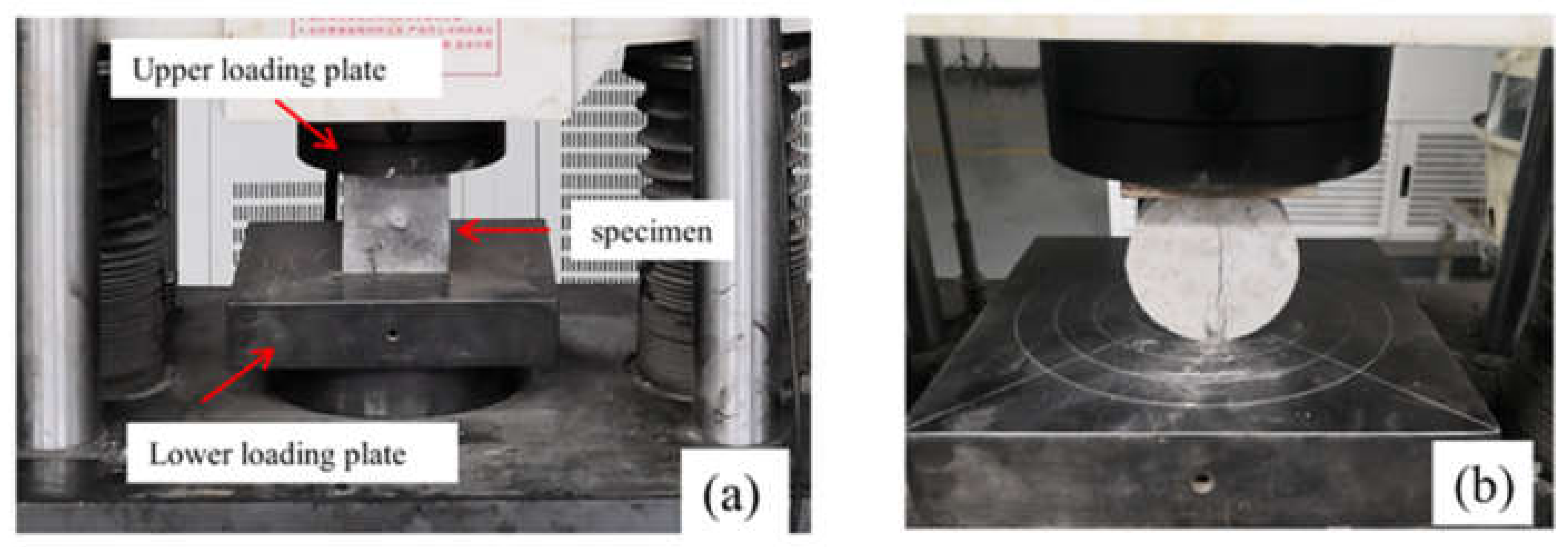
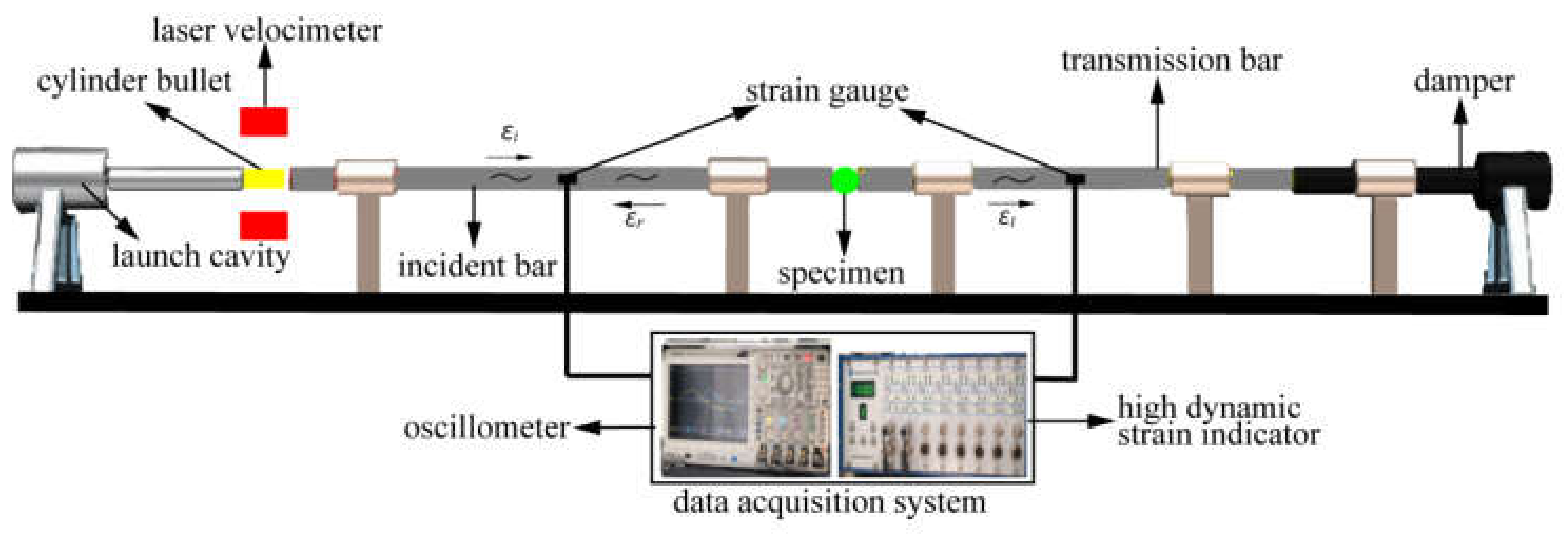
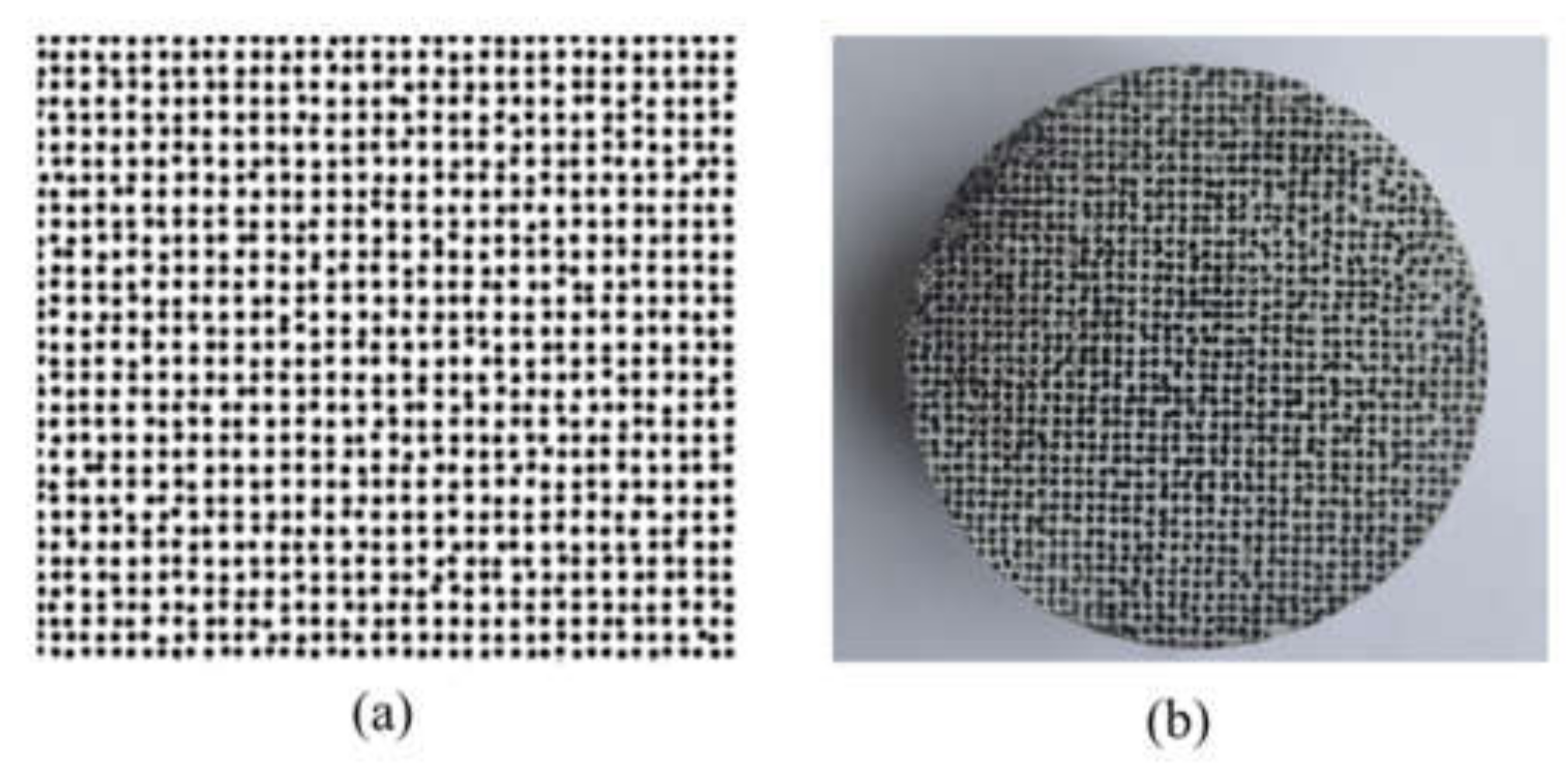
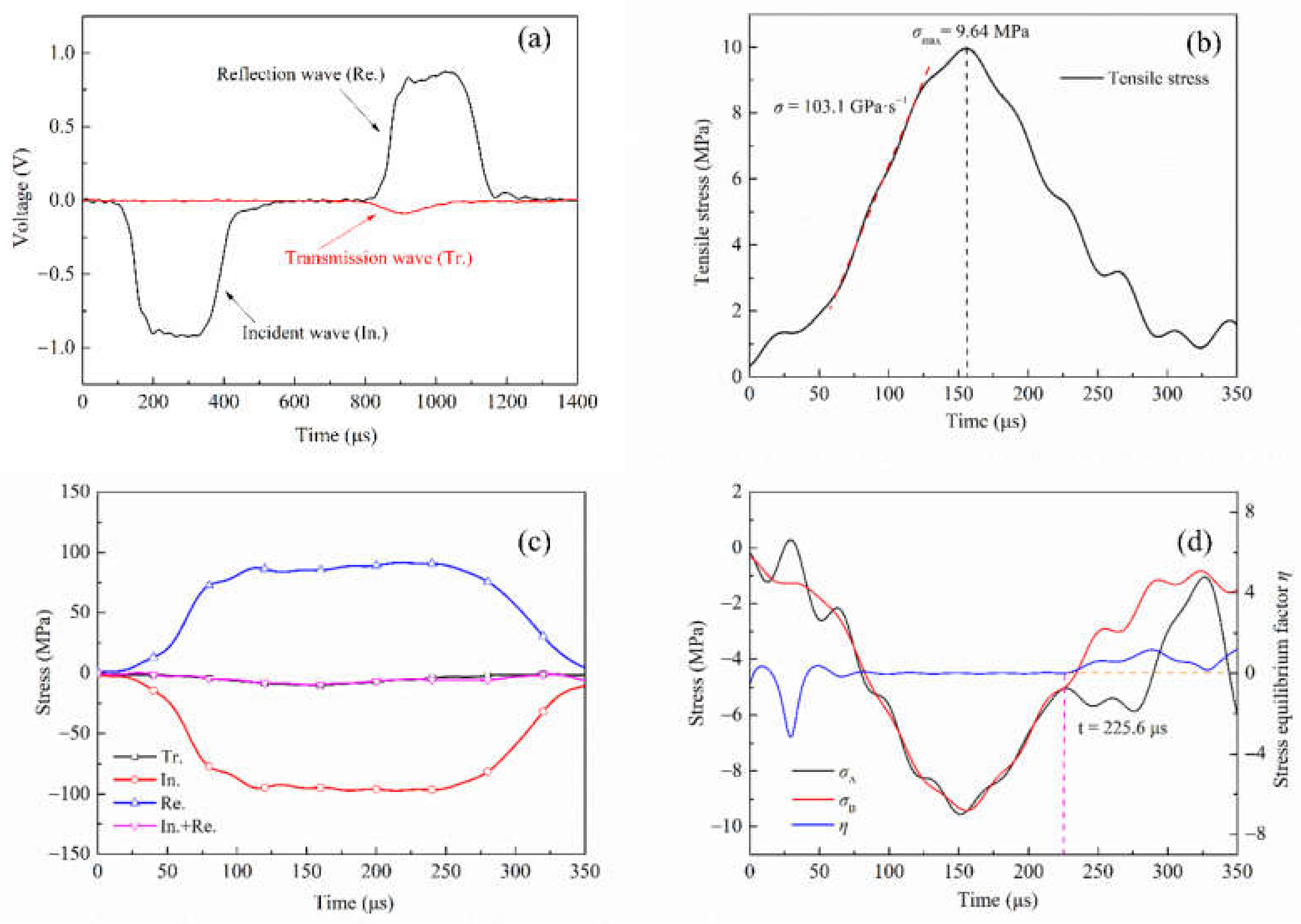
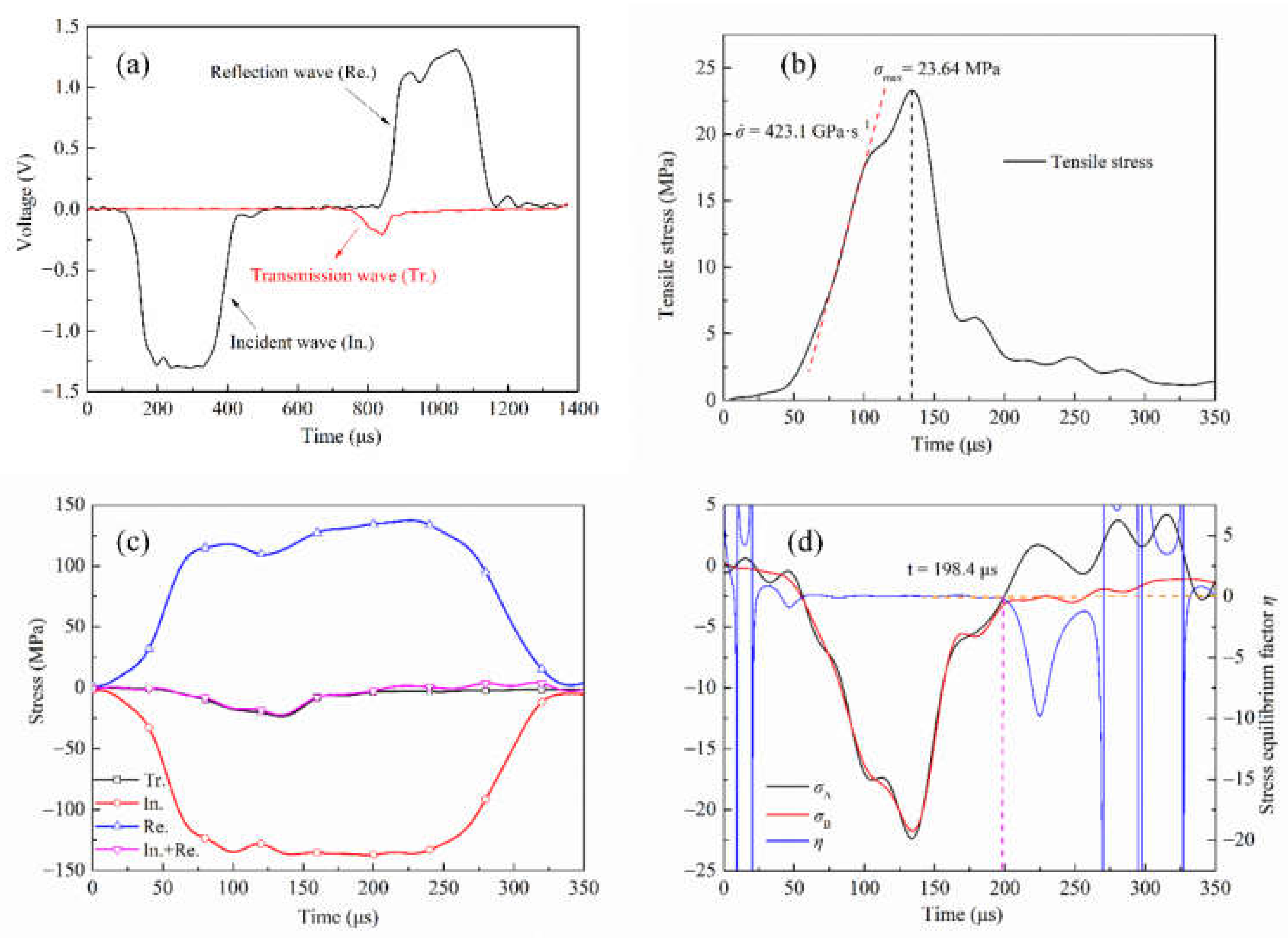



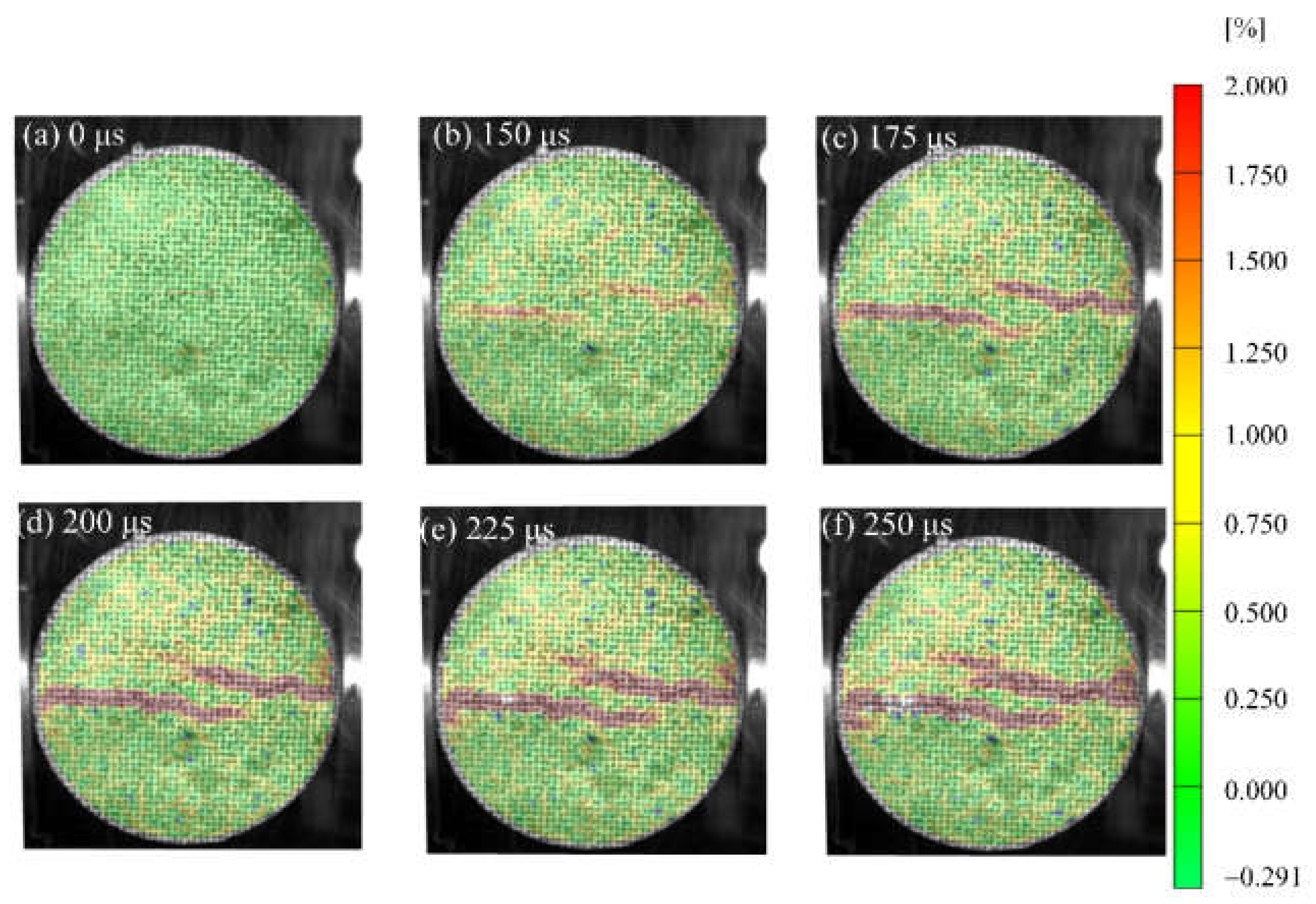



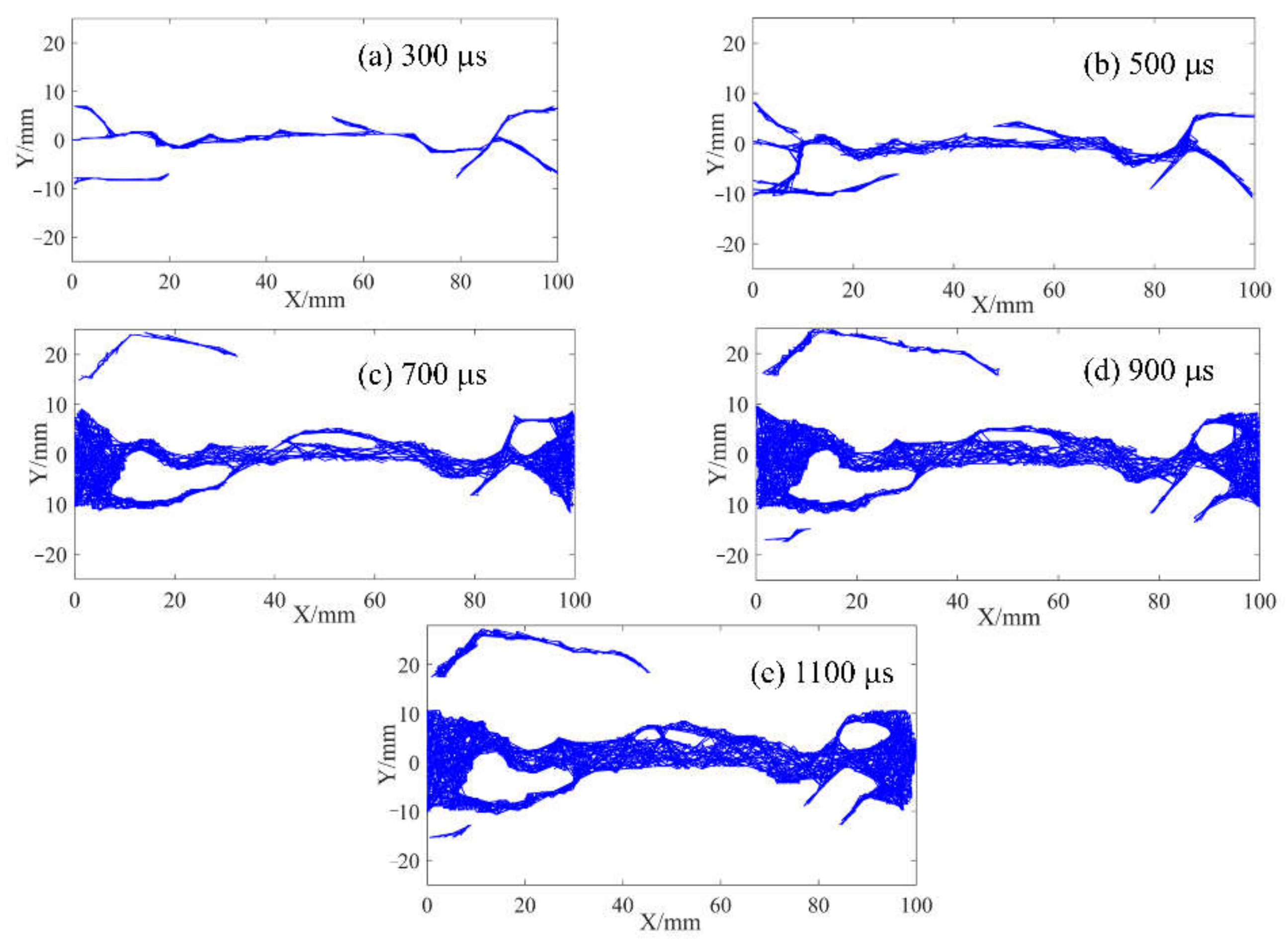
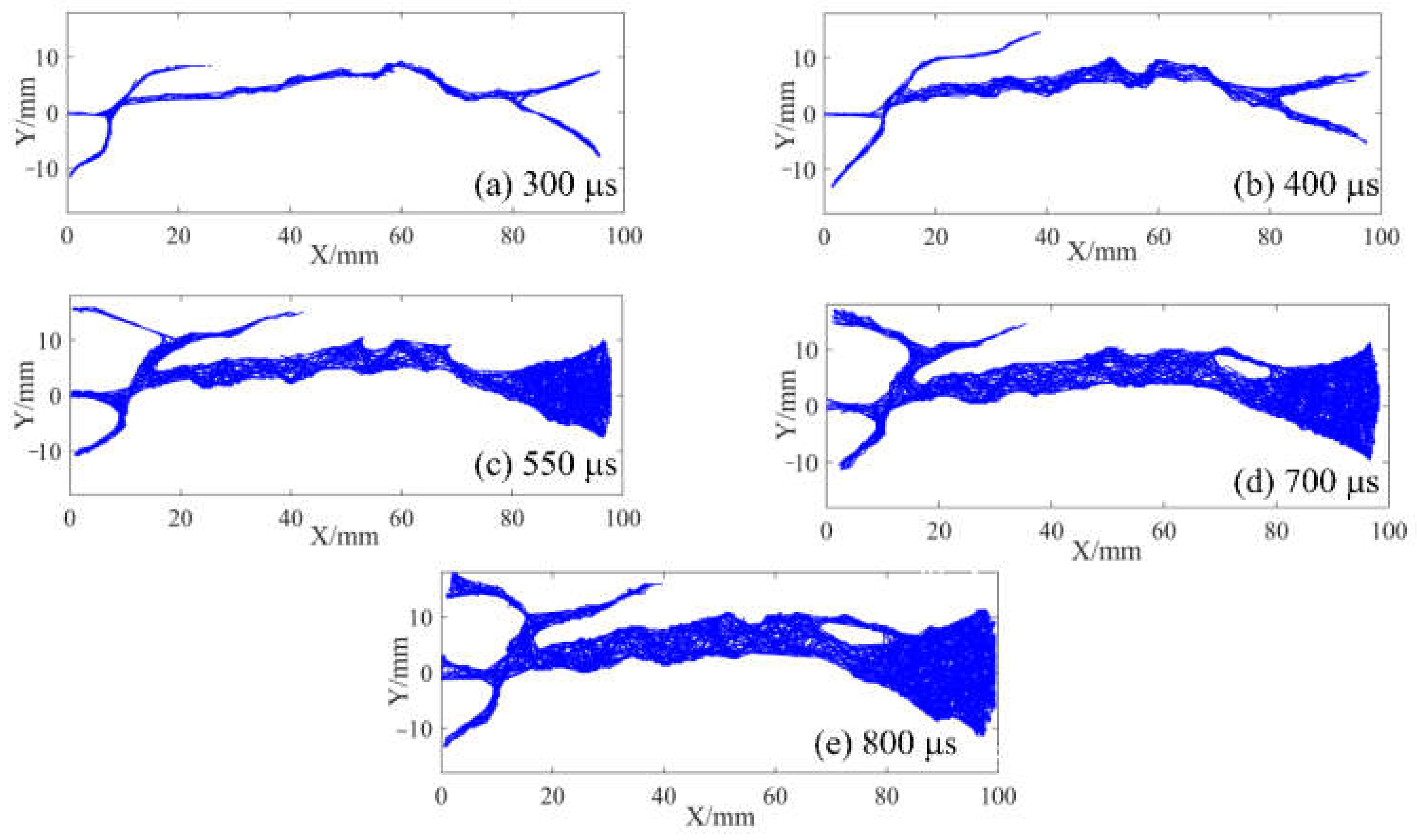
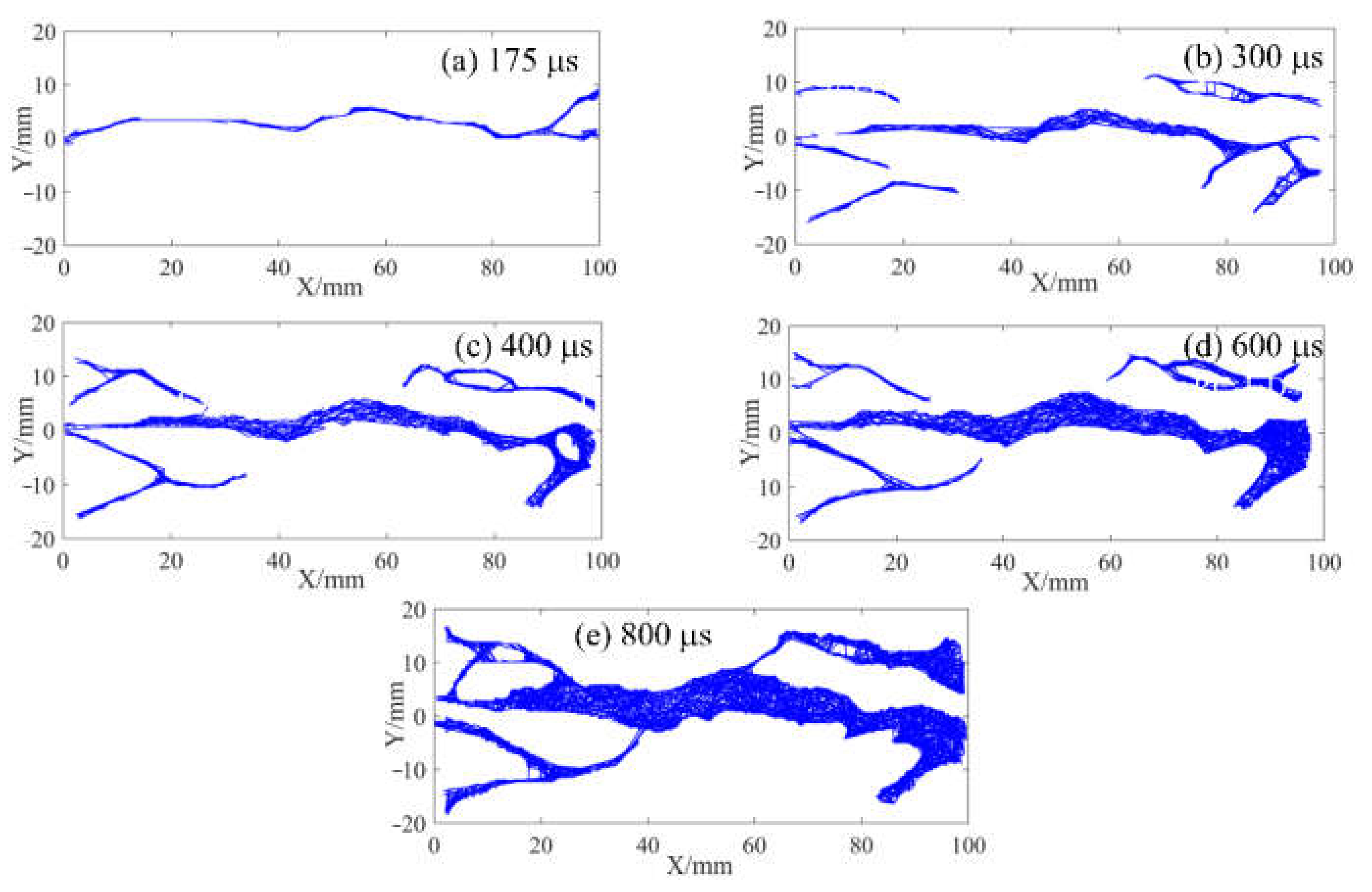
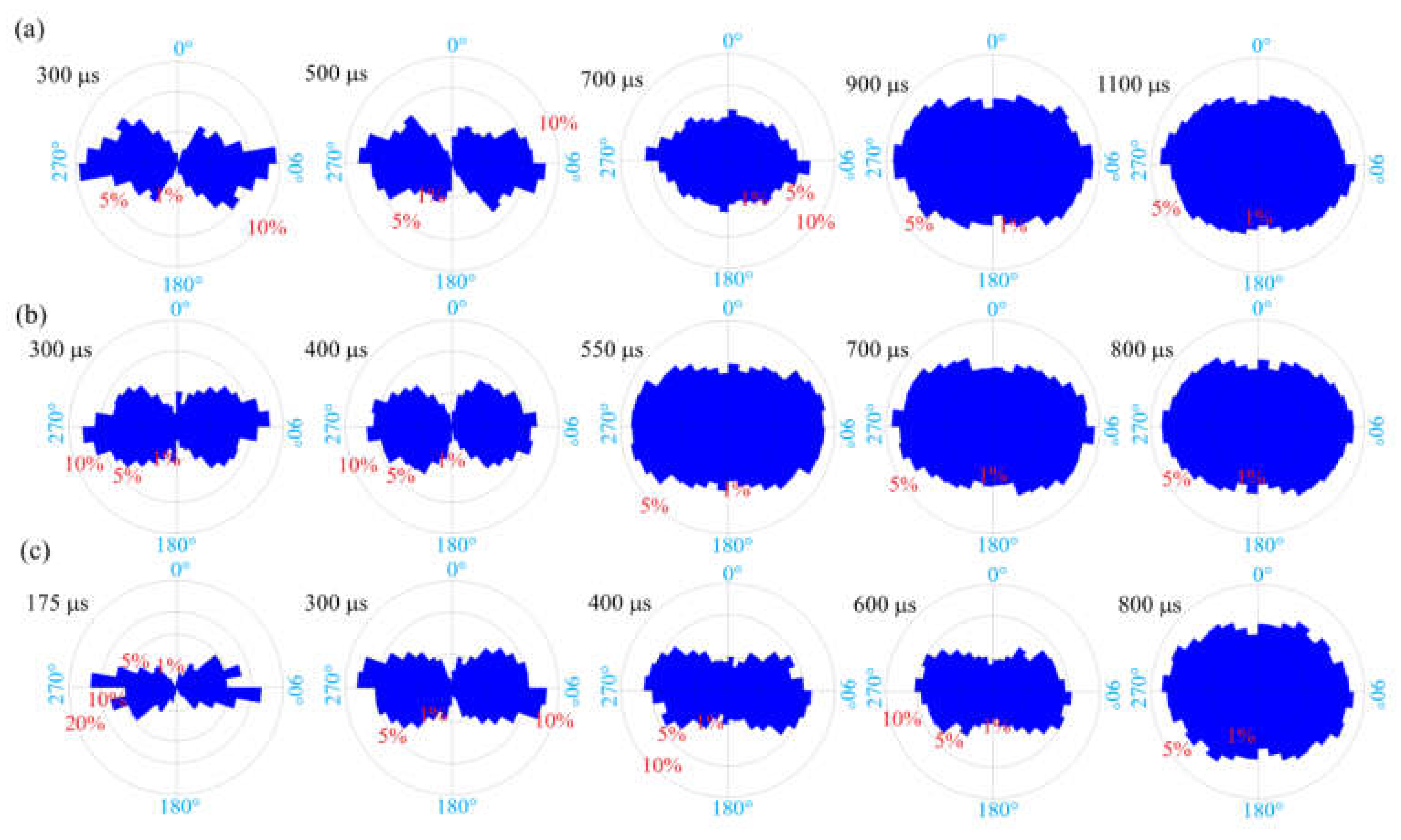
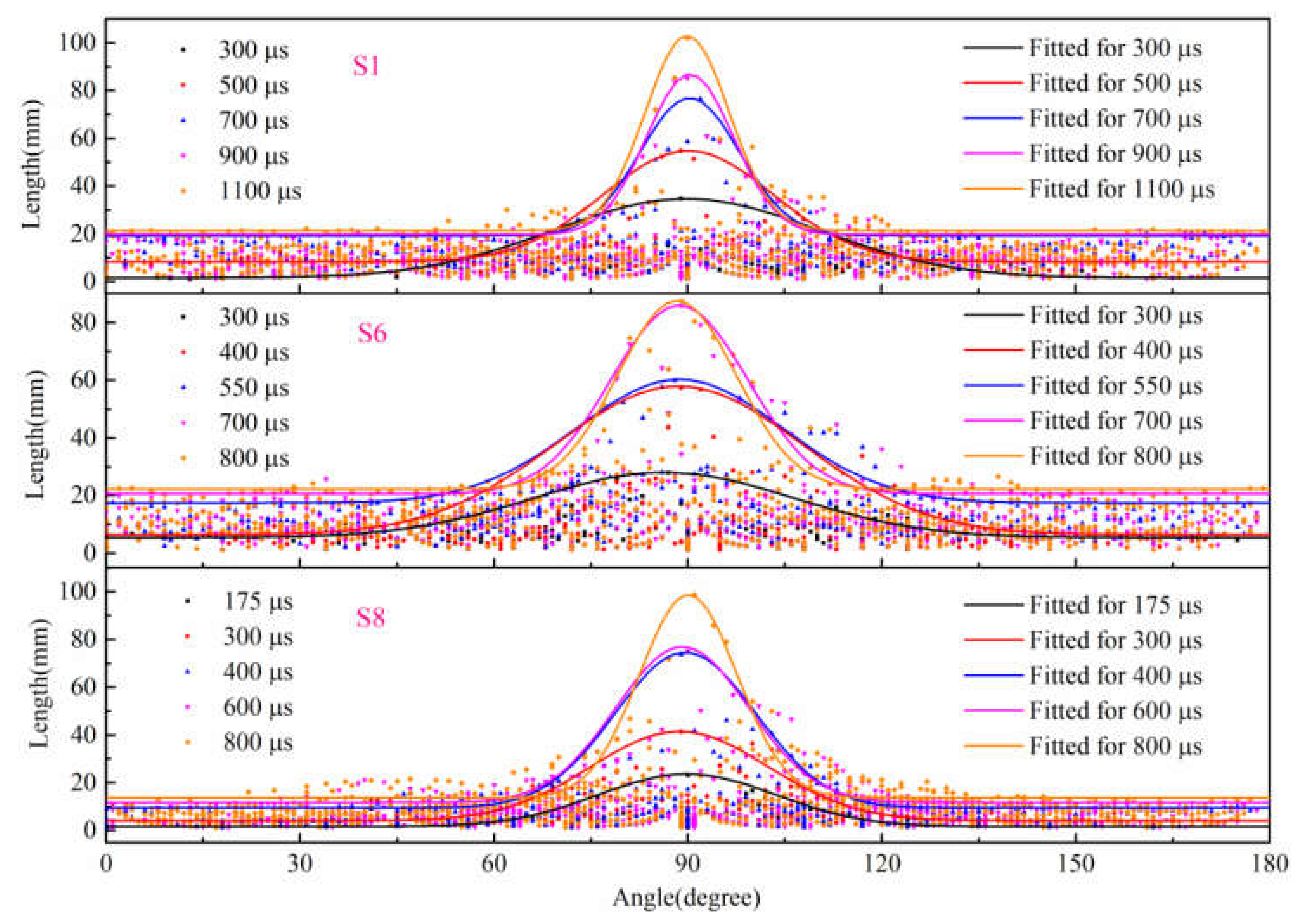

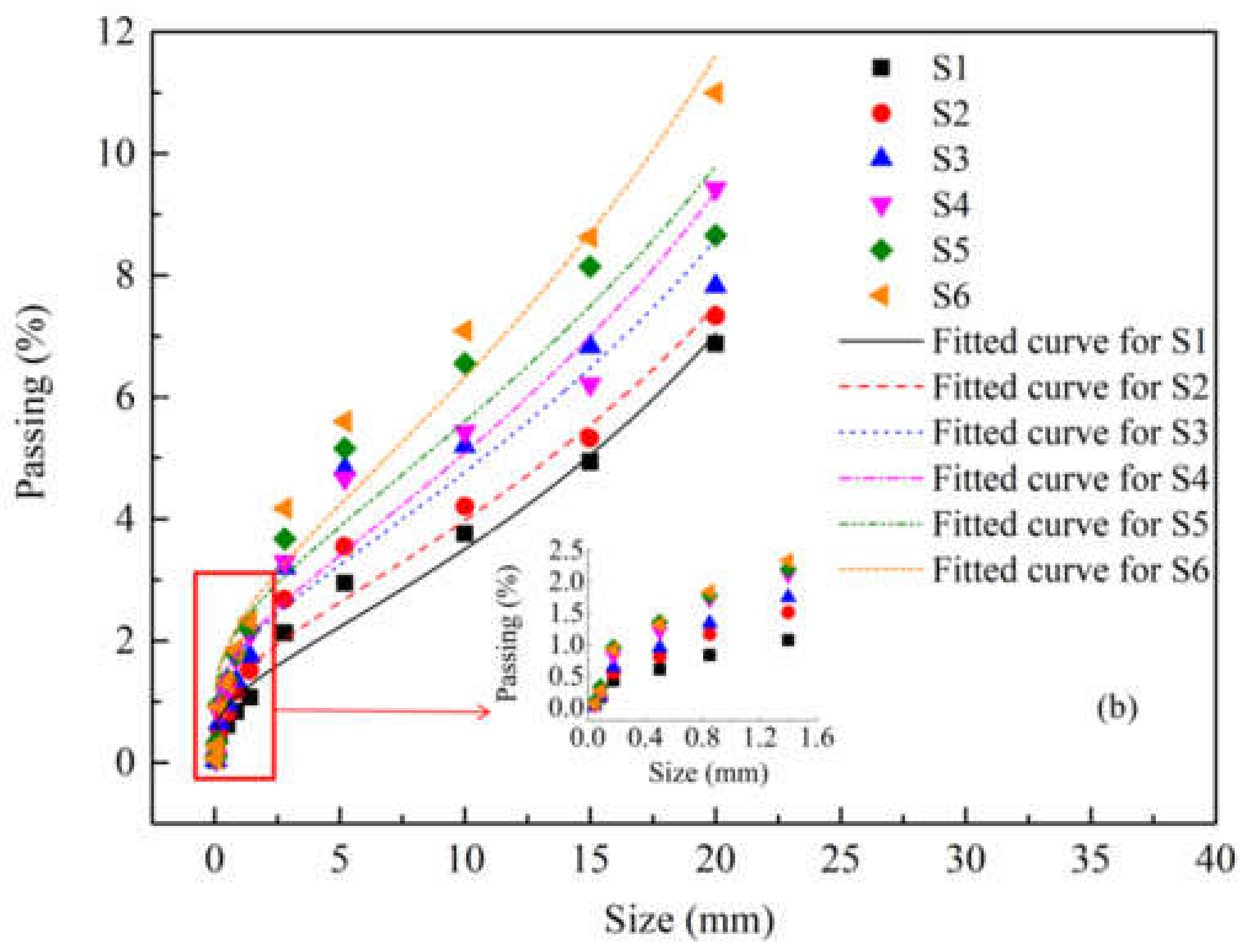
| Density (kg/m3) | BET (m2/g) | Chemical Composition (wt.%) (XRF) | |||||
|---|---|---|---|---|---|---|---|
| CaO | SiO2 | Al2O3 | Fe2O3 | SO3 | MgO | ||
| 1910 | 1.477 | 31.31 | 1.94 | 0.9 | 0.23 | 43.49 | 0.29 |
| Cement | Water | Fine Aggregate | Coarse Aggregate | Superplasticizer |
|---|---|---|---|---|
| 495 kg/m3 | 167 kg/m3 | 544 kg/m3 | 1251 kg/m3 | 10.4 kg/m3 |
| Specimen | Time (μs) | y0 | xc | w | A | R2 |
|---|---|---|---|---|---|---|
| S1 | 300 | 1.56 | 89.82 | 20.51 | 33.13 | 0.942 |
| 500 | 8.36 | 90.11 | 13.15 | 46.47 | 0.987 | |
| 700 | 19.22 | 90.37 | 7.73 | 57.78 | 0.947 | |
| 900 | 19.73 | 90.06 | 6.75 | 66.23 | 0.970 | |
| 1100 | 21.37 | 89.94 | 6.54 | 81.57 | 0.917 | |
| S6 | 300 | 5.40 | 86.29 | 20.18 | 22.61 | 0.891 |
| 400 | 6.43 | 88.58 | 19.27 | 51.48 | 0.987 | |
| 550 | 17.43 | 88.71 | 16.00 | 42.88 | 0.948 | |
| 700 | 20.51 | 88.67 | 10.64 | 65.35 | 0.878 | |
| 800 | 22.19 | 88.29 | 9.19 | 65.38 | 0.884 | |
| S8 | 175 | 1.56 | 89.88 | 13.79 | 22.12 | 0.926 |
| 300 | 4.12 | 88.69 | 13.69 | 37.42 | 0.958 | |
| 400 | 9.46 | 89.61 | 10.95 | 65.14 | 0.952 | |
| 600 | 11.73 | 89.13 | 10.34 | 65.22 | 0.917 | |
| 800 | 13.69 | 90.60 | 7.58 | 84.96 | 0.868 |
| Specimen | xmax (mm) | x50 (mm) | b | R2 | Stress Rate (GPa·s−1) |
|---|---|---|---|---|---|
| S1 | 50 | 44.07 | 1.30 | 0.9673 | 103.1 |
| S2 | 50 | 44.73 | 1.19 | 0.9512 | 150.3 |
| S3 | 50 | 44.78 | 1.12 | 0.9115 | 198.6 |
| S4 | 50 | 43.86 | 1.17 | 0.9441 | 318.8 |
| S5 | 50 | 44.52 | 1.07 | 0.9145 | 378.5 |
| S6 | 50 | 42.41 | 1.18 | 0.9459 | 423.1 |
Publisher’s Note: MDPI stays neutral with regard to jurisdictional claims in published maps and institutional affiliations. |
© 2022 by the authors. Licensee MDPI, Basel, Switzerland. This article is an open access article distributed under the terms and conditions of the Creative Commons Attribution (CC BY) license (https://creativecommons.org/licenses/by/4.0/).
Share and Cite
Xu, X.; Chi, L.-Y.; Yang, J.; Lv, N. Investigation on the Deformation and Failure Characteristics of Concrete in Dynamic Splitting Tests. Materials 2022, 15, 1681. https://doi.org/10.3390/ma15051681
Xu X, Chi L-Y, Yang J, Lv N. Investigation on the Deformation and Failure Characteristics of Concrete in Dynamic Splitting Tests. Materials. 2022; 15(5):1681. https://doi.org/10.3390/ma15051681
Chicago/Turabian StyleXu, Xuan, Li-Yuan Chi, Jun Yang, and Nao Lv. 2022. "Investigation on the Deformation and Failure Characteristics of Concrete in Dynamic Splitting Tests" Materials 15, no. 5: 1681. https://doi.org/10.3390/ma15051681






